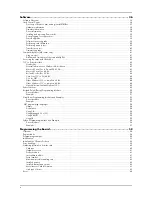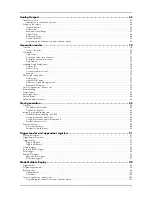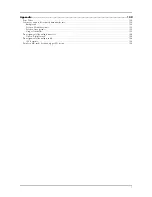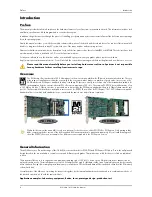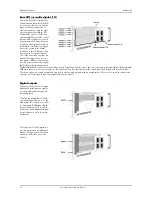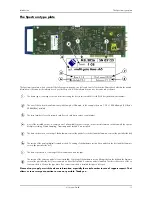
Introduction
Hardware information
(c) Spectrum GmbH
15
Technical Data
Analog Outputs
Trigger
Clock
Clock and Filter
Resolution
14 bit
Output amplitude
software programmable
±100 mV up to ±3 V in 1 mV steps (Amp option: ±333 mV up to ±10 V in 3 mV steps)
Output offset
software programmable
±3 V in 1 mV steps (Amp option: ±10 V in 3 mV steps)
Filters
software programmable
no filter or one of 3 different filters as defined in technical data section
DAC Differential non linearity (DNL)
DAC only
±1.5 LSB typical
DAC Integral non linearity (INL)
DAC only
±1.0 LSB typical
Output resistance
< 1 Ohm
Minimum output load
35 Ohm (not short circuit protected)
Max output swing in 50 Ohm
± 3 V ( amplitude)
Max slew rate (no filter)
> 0.9 V/ns
Crosstalk @ 1 MHz signal ±3 V
< -80 dB
Output accuracy
< 1%
Running mode
software programmable
Singleshot, FIFO mode (Streaming), Repeated Replay, Single Restart, Sequence Mode
Trigger edge
software programmable
Rising edge, falling edge or both edges
Trigger pulse width
software programmable
0 to [64k - 1] samples in steps of 1 sample
Trigger delay
software programmable
0 to [64k - 1] samples in steps of 1 sample
Memory depth
software programmable
8 up to [installed memory / number of active channels] samples in steps of 4
Multiple Replay segment size
software programmable
8 up to [installed memory / 2 / active channels] samples in steps of 4
Multiple Replay, Gated Replay: re-arming time
<
4 samples
Trigger output delay
One positive edge after internal trigger event
Internal/External trigger accuracy
1 sample
External trigger type (input and output)
3.3V LVTTL compatible (5V tolerant)
External trigger input
Low
≤
0.8 V, High
≥
2.0 V,
≥
8 ns in pulse stretch mode,
≥
2 clock periods all other modes
External trigger maximum voltage
-0.5 V up to +5.7 V (internally clamped to 5.0V, 100 mA max. clamping current)
Trigger impedance
software programmable
50 Ohm / high impedance (> 4kOhm)
External trigger output type
3.3 V LVTTL
External trigger output levels
Low
≤
0.4 V, High
≥
2.4 V, TTL compatible
External trigger output drive strength
Capable of driving 50 ohm load, maximum drive strength ±128 mA
Output delay trigger to 1st sample
15/16 clocks (2/1 channel/module)
Gate end to last replayed sample
15/16 clocks (2/1 channel/module)
Gate end alignment
2 samples (1 ch), 1 sample (2 or 4 ch)
Clock Modes
software programmable
internal PLL, internal quartz, external clock, external divided, external reference clock, sync
Internal clock range (PLL mode)
software programmable
1 kS/s to max using internal reference, 50kS/s to max using external reference clock
Internal clock accuracy
≤
20 ppm
Internal clock setup granularity
≤
1% of range (100M, 10M, 1M, 100k,...): Examples: range 1M to 10M: stepsize
≤
100k
External reference clock range
software programmable
≥
1.0 MHz and
≤
125.0 MHz
External clock impedance
software programmable
50 Ohm / high impedance (> 4kOhm)
External clock range
see „Dynamic Parameters“ table below
External clock delay to internal clock
5.4 ns
External clock type/edge
3.3V LVTTL compatible, rising edge used
External clock input
Low level
≤
0.8 V, High level
≥
2.0 V, duty cycle: 45% - 55%
External clock maximum voltage
-0.5 V up to +3.8 V (internally clamped to 3.3V, 100 mA max. clamping current)
External clock output type
3.3 V LVTTL
External clock output levels
Low
≤
0.4 V, High
≥
2.4 V, TTL compatible
External clock output drive strength
Capable of driving 50 ohm load, maximum drive strength ±128 mA
Synchronization clock divider
software programmable
2 up to [8k - 2] in steps of 2
ABA mode clock divider for slow clock
software programmable
8 up to 524280 in steps of 8
M2i.6011
M2i.6012
M2i.6021
M2i.6022
M2i.6030
M2i.6033
M2i.6031
M2i.6034
max internal clock
20 MS/s
62.5 MS/s
125 MS/s
125 MS/s
max external clock
20 MS/s
62.5 MS/s
125 MS/s
125 MS/s
-3 dB bandwidth no filter
> 10 MHz
> 30 MHz
> 60 MHz
> 60 MHz
Filter 3: Characteristics
4th order Butterworth
5th order Butterworth
Filter 3: -3 dB bandwidth
5 MHz (typ. 5.4 MHz)
10 MHz (typ. 11.4 MHz)
25 MHz (typ. 26.5 MHz)
25 MHz (typ. 26.5 MHz)
Filter 2: Characteristics
4th order Butterworth
4th order Butterworth
Filter 2: -3 dB bandwidth
1 MHz (typ. 1.2 MHz)
2 MHz (typ. 2.4 MHz)
5 MHz (typ. 5.8 MHz)
5 MHz (typ. 5.8 MHz)
Filter 1: Characteristics
4th order Butterworth
4th order Butterworth
Filter 1: -3 dB bandwidth
100 kHz (typ. 96 kHz)
200 kHz (typ. 200 kHz)
500 kHz (typ. 495 kHz)
500 kHz (typ. 495 kHz)




